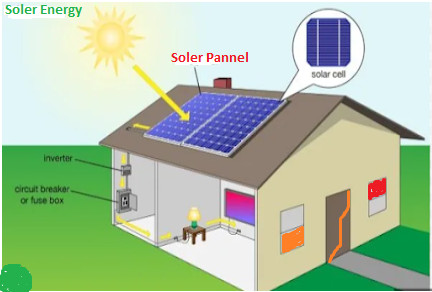
Introduction of Soler System
All the energy that exists and is being used on earth is somehow obtained from the sun. The energy that comes from the sun is called solar energy. Solar cells have been manufactured using modern techniques. Solar cells or cells are actually photosensitive p-n junctions made of silicon. The solar panel is composed of solar cells which are the main part of the solar system. Now the method of storing and using electricity produced from solar panels is solar system.
Classification of Soler system
Solar system is divided into two parts namely:
1.off-grid Soler system
2. On-grid Soler system


Working Principal of Soler System
Solar panels used in solar systems work on the photo voltaic energy conversion system. In this method solar energy is generated DC directly through solar cells. By the mechanical system that shines light on a p-n junction and converts light energy into electrical energy, it is called a solar cell or cell. The amount of light energy depends on the light intensity and the illuminated area. Photo voltage is generated when solar cells are exposed to sunlight. Each solar cell produces between .5 volts and 1 volt DC, depending on the material used in the solar cell and the amount of sunlight. The voltage or current can be increased by connecting the required number of solar cells in series or parallel.

The sun oriented photovoltaic chips away at the standard of photovoltaic impact. It is the physical and substance property or peculiarity in which electromotive power is created in the non-homogeneous materials with the brightening of light of a particular frequency.
Sun based power works by changing over energy from the sun into power. There are two types of energy created from the sun for our utilization – power and intensity. Both are produced using sun powered chargers, which range in size from private roofs to ‘sun based homesteads’ extending over sections of land of provincial land
At the point when daylight strikes a sun based cell, electrons in the silicon are launched out, which brings about the development of “openings” — the opportunities abandoned by the getting away from electrons. Assuming this occurs in the electric field, the field will move electrons to the n-type layer and openings to the p-type layer.
The PV cells in a solar panel absorb energy from the sun when it shines on them. This energy makes electrical charges that move in light of an inside electrical field in the cell, making power stream.
The sun radiates light, even on shady days. The panels’ PV cells convert the light into DC electricity. The current enters an inverter, where it is converted into usable AC electricity. The current enters the consumer unit of your home after passing through a meter.
Photons can bounce off a PV cell, travel through the cell, or be absorbed by the semiconductor material when they hit it. To generate electricity, only the absorbed photons provide energy. Electrons are released from the material’s atoms when enough sunlight (solar energy) is absorbed by the semiconductor.
PV cells make use of a variety of different semiconductor materials. At the point when the semiconductor is presented to light, it retains the light’s energy and moves it to adversely charged particles in the material called electrons. The electrons can move through the material like an electrical current thanks to this additional energy.
Use of Soler System
The practical areas of solar systems are mentioned below:
1.Home Electrical Appliance
2. Power Grid System
3. Power Station
4. Mills and Industries


